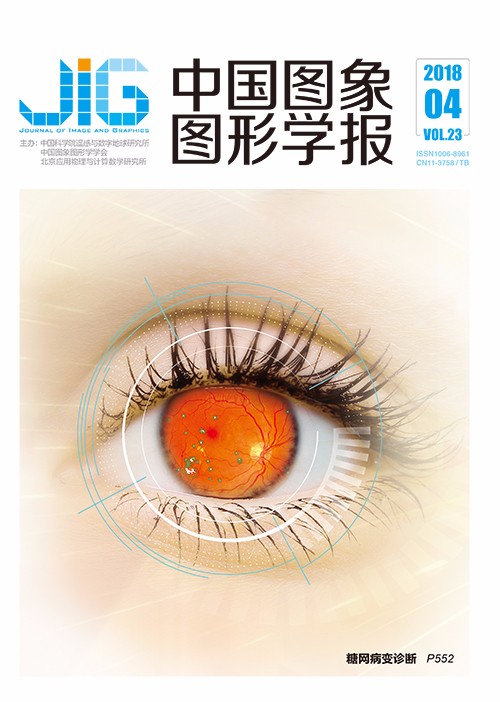
使用霍夫变换的3维点云拼合算法
摘 要
目的 直接基于点云数据本身的拼合算法对点云模型的位置和重叠度有着较高的要求。为了克服这种缺陷,提出一种针对散乱点云的分步拼合算法。方法 不同于大多数已有的基于曲率信息的拼合算法,本文算法包含了一个序贯式的匹配点对筛选过程和一个基于霍夫变换的坐标变换参数估计过程。在筛选过程中,首先利用曲率相似度确定点云数据之间的初始匹配关系,然后利用刚体不变量特征邻域标识相似度以及持续特征直方图相似度对初始匹配点对进行连续两次筛选以便得到更为精确的匹配点对集。在参数估计阶段,通过对匹配点对的旋转矩阵和平移矢量的参数化处理,利用霍夫变换消除错误匹配点对对坐标变换参数估计的影响,从而得到更加准确的坐标变换参数,实现点云的3维拼合。结果 利用本文算法对两片部分重叠的点云数据进行了拼接实验。实验结果表明,本文算法能很好地实现对部分重叠点云的拼合。由于霍夫变换的引入,本文算法相较于经典的Ransac算法具有更高的正确率、稳定性以及抗噪性,在运行速度上也具有一定的优越性。结论 本文算法不仅能适用于任何具有任意初始相对位置的部分重叠点云的拼接,而且可以取得很高的拼合精度和很好的噪声鲁棒性。
关键词
Three-dimension registration method for point cloud data using the Hough transform
Wu Xiao, Chen Congmei, Wang Jiajun(School of Electronic and Information Engineering, Soochow University, Suzhou 215006, China) Abstract
Objective Typical cloud data registration methods based on cloud data have high demands on the locations and overlapping degree of the two cloud datasets to be registered. For instance, the iterative closest point (ICP) algorithm establishes the corresponding relationship by searching the closest points, usually measured in Euclidean distance, between two point sets. Poor initial positions of two point cloud sets commonly lead to many erroneous correspondences, and eventually only local optimal solutions can be obtained rather than the global optimal solution. In addition, the ICP algorithm has high requirements on the overlapping degree between two clouds to be registered. To tackle this problem, we propose a step-by-step registration algorithm for the registration of scattered cloud data. Method Different from most existing curvature-based registration algorithms, our proposed method consists of one sequential filtering process for erroneously matched point pairs and one parameter estimation process based on the Hough transform. In the filtering process, the point cloud curvature and other geometric derivative information were calculated, and the candidate matched point pairs from different clouds were extracted subsequently on the basis of the curvature. For the further elimination of the erroneously matching point pairs, these candidates were sequentially filtered on the basis of two similarity measures for the invariant signature and the persistence feature histogram. In the parameter estimation stage, the Hough transform was used to remove the contributions of the erroneously matched point pairs and to determine the final transform for registration upon parameterizing the rotation matrices and the translation vectors of these point pairs. Result The proposed algorithm is used to register the bunny point cloud data downloaded from the official website of Stanford University for validation. To do so, the entire point cloud data are initially divided into two overlapping point cloud datasets. The overlapping degree of these two cloud datasets is approximately 22%. One of the point cloud datasets is subjected to arbitrary translation and rotation operations. Our proposed algorithm is then employed for the registration of the aforementioned two partially overlapped cloud datasets. The initial matching point set is extracted on the basis of curvature similarity, and then the similarity measures of the invariant features are used as the first filter to eliminate erroneously matched point pairs. Experimental results corroborate that approximately twice improvement in the accuracy of the matching points can be achieved upon employing the filter based on the invariant feature. Subsequently, the similarity measures of the continuous feature histogram are used as the second filter for the previously obtained matching point pairs. The results of this procedure affirm that approximately twice improvement in the average accuracy is achieved. Finally, clustering analysis is performed on the basis of the Hough transform to obtain the final coordinate transformation parameters from the aforementioned matching point pairs and to further eliminate the contribution of the outliers of the matching points to the transformation parameters. Our proposed algorithm, which used the Hough transform, is compared with the classical Ransac algorithm. The number of random sampling is set to k=1000, and the distance from the point to the space line threshold is set to 0.08 to match the parameters of the sphere space. At the 1% noise level, the matching points using the Hough algorithm accuracy is 92.67%, and the average accuracy of the Ransac algorithm is 88.2%. At the 5% noise level, 50% matching accuracy can be achieved with the Hough transform-based algorithm, whereas that of the Ransac algorithm is 18.4%. Additionally, at each noise level, the results from each run of the Ransac algorithm cannot be repeated, implying that the stability of the Ransac algorithm is poor. Thus, our method outperforms the classical Ransac algorithm in accuracy, stability, and robustness to noise. Moreover, our method runs faster than that based on the Ransac algorithm. Conclusion Our proposed algorithm can be used for the registration of any partially overlapped clouds with any relative deviation and achieve high accuracy and robustness to noise. The proposed algorithm is time-consuming because it requires step-by-step implementations. Our future work will concentrate on investigating the point cloud data reduction strategy and its corresponding combination method to improve the efficiency of the algorithm further.
Keywords
point clouds registration invariant signature hough transform persistence feature histogram match normal vector adjustment curvature
|



 中国图象图形学报 │ 京ICP备05080539号-4 │ 本系统由
中国图象图形学报 │ 京ICP备05080539号-4 │ 本系统由